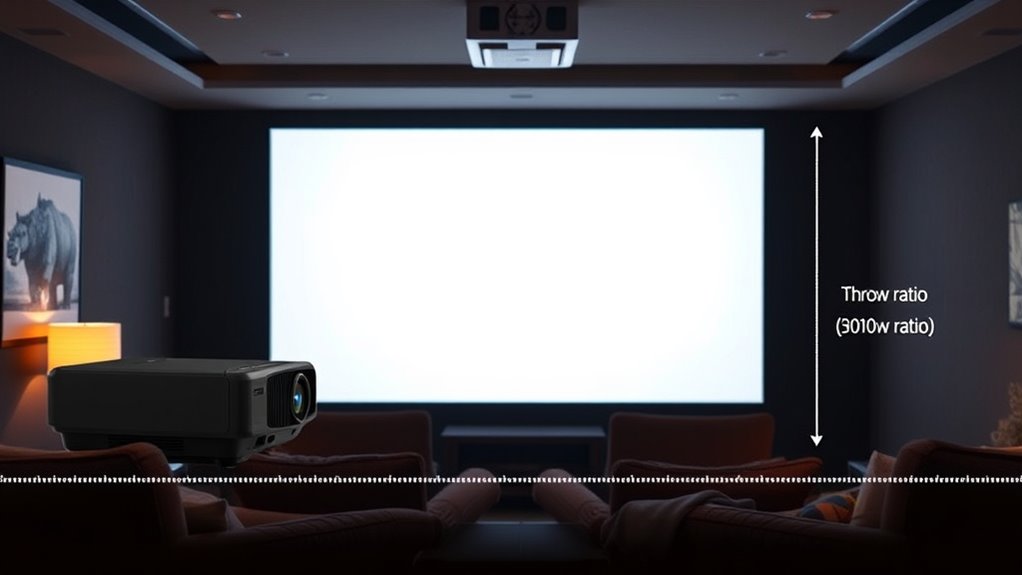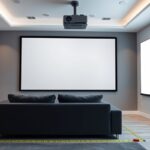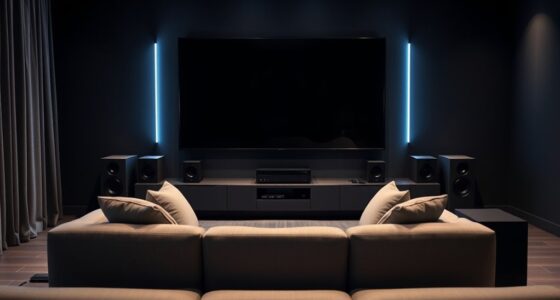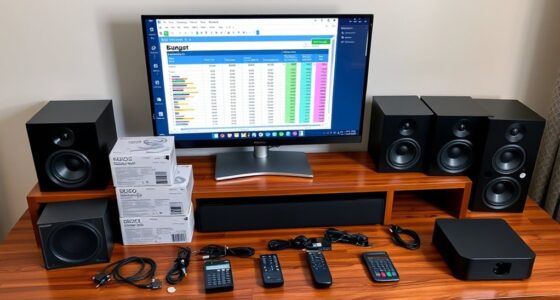Understanding throw ratio and screen size helps you choose the right projector placement for your space. The throw ratio tells you how far the projector needs to be from the screen to get your desired image size. A short throw ratio works well in small rooms, while a long throw suits larger spaces. Knowing these factors guarantees sharp images without distortion. Keep exploring to learn how to optimize your projector setup for any room.
Key Takeaways
- Throw ratio indicates the relationship between projector distance and projected image width.
- A lower throw ratio allows larger images from closer distances, ideal for small spaces.
- Properly calculating throw ratio ensures the projector can produce the desired screen size at a specific distance.
- Selecting the right throw ratio helps optimize space and prevents image distortion or blurriness.
- Understanding throw ratio aids in accurate projector placement for optimal image clarity and viewing experience.
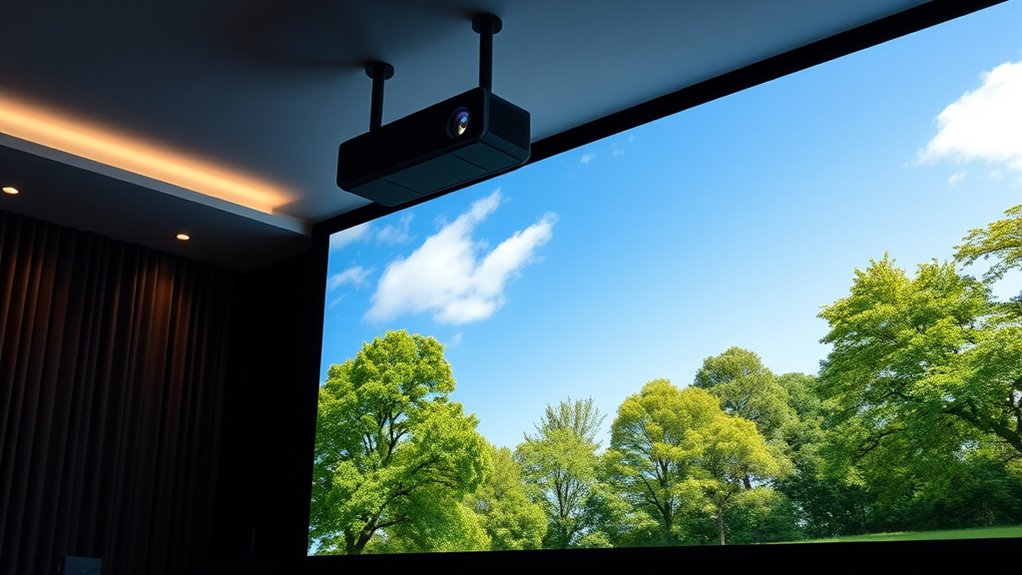
When choosing a projector, understanding throw ratio and screen size is vital because these factors determine how large your image will be at a given distance. The throw ratio is a simple but key measurement that indicates how far the projector must be from the screen to produce a specific image size. For example, a throw ratio of 1.5:1 means that for every 1.5 feet of projection distance, you’ll get a 1-foot-wide image. This relationship helps you decide where to place your projector in relation to your screen to achieve the desired size without sacrificing image clarity. If your space is limited, a projector with a short throw ratio allows you to project large images from a short distance, making it versatile for small rooms. Conversely, a long throw projector requires more space but can produce larger images from farther away, which is ideal for bigger venues. Additionally, understanding the technical aspects of arcade machines can provide insights into how different gaming hardware operates, further enhancing your setup. Your projection distance directly impacts the image quality you experience. If you position the projector too close or too far from the screen, you risk distortions, blurriness, or a loss of sharpness. Properly calculating the projection distance based on the throw ratio guarantees that your image remains crisp and clear. When the projector is correctly aligned, you maximize image clarity, making details sharp and colors vibrant. This is especially important if you’re using the projector for presentations or movie nights, where clarity enhances the viewing experience. Knowing the relationship between projection distance and screen size helps you avoid the frustration of an image that’s either too small or too distorted because of incorrect placement.
Frequently Asked Questions
How Does Ambient Light Affect Projected Image Quality?
Ambient light can considerably influence your projected image quality. When there’s too much ambient light, your image appears washed out, making details hard to see. To improve clarity, you might need a brighter projector or a darker room. Minimizing ambient light guarantees your image stays sharp, colorful, and vibrant, providing a better viewing experience. So, controlling ambient light is essential for maintaining ideal image quality during projection.
Can Throw Ratio Be Adjusted Without Changing the Projector?
You can’t adjust throw ratio without changing the projector, but you can modify your setup. Using lens shift helps reposition the image without distorting it, which can give the appearance of adjusting throw. If you try to alter the throw ratio directly, it may cause image distortion or uneven focus. So, instead, move your projector or adjust the lens shift to fine-tune the image placement without affecting the throw ratio.
What Is the Ideal Screen Size for Small Rooms?
In small rooms, aim for a screen size between 80 to 100 inches to optimize viewing without overwhelming the space. Measure your room dimensions carefully to guarantee the screen fits comfortably while maintaining good viewing angles. A larger screen enhances your experience, but avoid going too big, which could crowd the room or cause discomfort. Find a balance that suits your space and enhances your viewing pleasure.
How Do Lens Shift and Zoom Impact Image Positioning?
A picture is worth a thousand words, so knowing how lens shift and zoom flexibility impact image positioning is key. Lens shift lets you move the image vertically or horizontally without moving the projector, while zoom flexibility adjusts the image size without affecting placement. Together, they give you precise control, making it easier to align your screen perfectly and avoid distortion or keystone effects.
Are Short-Throw Projectors Suitable for Large Venues?
Short-throw projectors are generally not suitable for large venues because their design is optimized for smaller spaces where they can project a large image from a short distance. In large venues, you’d need a standard or long-throw projector that can cover bigger areas from a greater distance. Short throw projectors excel in classrooms or small conference rooms but fall short in delivering the scale needed for large-scale events.
Conclusion
Now that you understand throw ratio and screen size, you can choose the perfect projector for your space. Remember, a 1.0 throw ratio means your projector can be placed just one meter from the screen for a 1-meter image, making setup flexible. notably, 90% of home theater enthusiasts prefer projectors with a throw ratio under 1.5 for easier installation. With this knowledge, you’re ready to create a stunning, immersive viewing experience tailored to your room.
